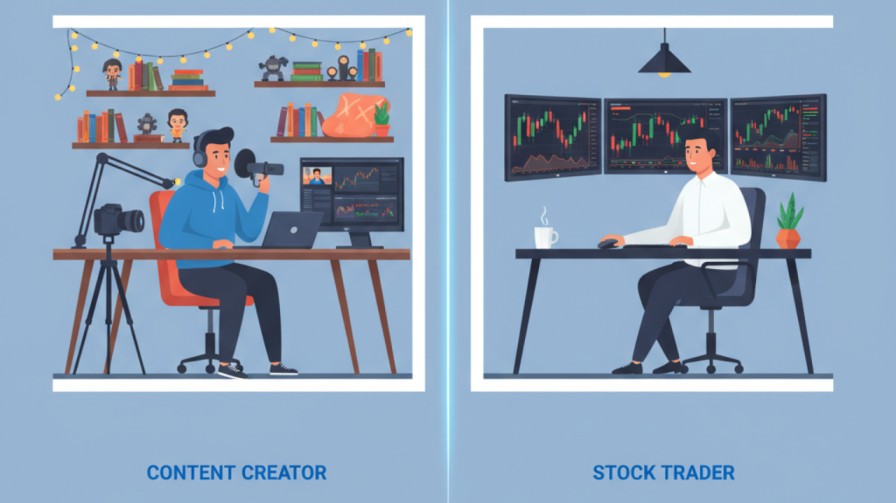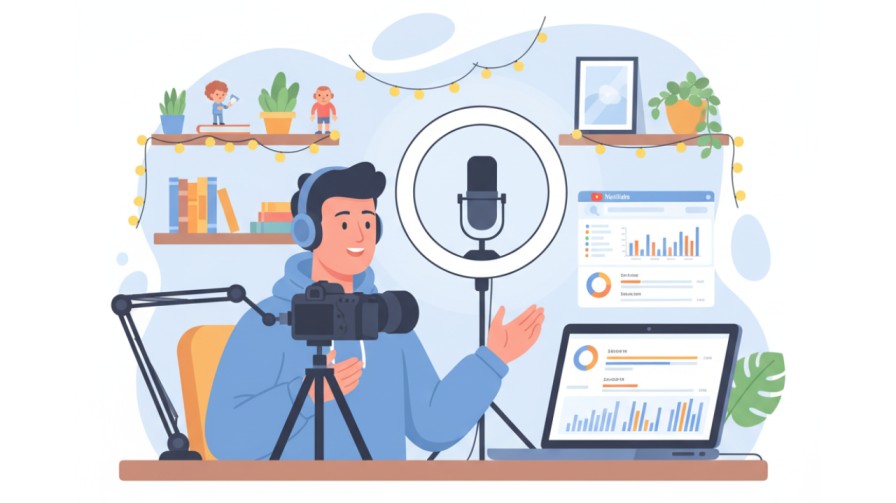If you look around today, almost everyone wants an extra source of income. Some people dream of being a YouTuber; others spend late nights studying charts and order tickets in their trading account. On one side you build community and content; on the other you try to turn capital into returns. Both paths are valid — but very different.
This article goes beyond lists and pros/cons. I’ll walk you through how each path actually plays out, the psychological traps, realistic income scenarios, and a practical hybrid plan if you don’t want to choose.

The YouTube Path — patience, creativity, then compounding
YouTube is an attention economy. If you can capture attention — teach, entertain, or solve a problem — you can eventually monetize that audience. But the process is rarely instant. Most creators find their first real monthly income after many months of consistent uploads.
The money comes from a mix: AdSense (ads on videos), sponsorships, affiliate links, and direct revenue like merch or memberships. Importantly, the niche matters. A finance video will typically earn much more per view than a reaction or comedy video because advertisers in finance pay higher CPMs.

Real example: a niche finance creator who publishes clear, trustworthy tutorials and market explainers may reach $10–$30 RPM (or more) with US traffic. That means 100,000 targeted views could translate into a few thousand dollars — and that income recurs as long as the videos keep getting views.
But YouTube’s biggest cost is time and energy. You might spend months producing videos that barely move the needle. The reward is compounding: older videos keep earning, community grows, and sponsorships appear as your authority rises.
Why creators fail early
- They quit before compounding takes effect.
- They copy trends without building a unique voice.
- They avoid niches that pay well for ads (like finance or tech).
The Trading Path — speed, discipline, and capital risk
Trading is fundamentally different. Where YouTube asks for creativity and patience, trading asks for discipline, systems, and real money on the line. You can make money quickly — or lose it just as quickly.

There are many flavors: swing trading, day trading, forex, crypto, and long-term investing. Each has a different time horizon and risk profile. A disciplined trader uses rules: position sizing, stop losses, and a tested strategy. Emotion is the real enemy — greed, fear, and impatience destroy accounts more often than bad systems.
Real example: a carefully managed $10,000 trading account might generate 5–20% annual returns for a consistent, risk-aware trader. That could be $500–$2,000 in a month at times — but remember: losses can and do occur.
Why many traders burn out
- They risk too much per trade.
- They chase "hot tips" without a plan.
- They don’t accept losses and overtrade to recover.
Head-to-head: practical comparison
| Factor | YouTube | Trading |
|---|---|---|
| Primary Cost | Time & creative effort | Financial capital (risk of loss) |
| Time to meaningful income | 6–24 months | Immediate to months (skill dependent) |
| Upside | High (scale with audience) | High (depends on capital & strategy) |
| Downside | Burnout & lost time | Financial loss |
A smarter play: combine both
You don’t have to pick only one. In fact, the most resilient creators combine them: build a finance-focused YouTube channel and use part of the ad and sponsorship income to fund trading or investing. That does two things:
- Gives you a runway to learn trading without risking all your capital.
- Turns trading activity into content — growth, losses, and lessons become videos that attract viewers.
Many creators document their investing journey. Even a losing month can produce a popular, honest video that earns revenue and strengthens your brand.
Practical advice if you’re starting today
- If you love storytelling: start a YouTube channel; pick a niche and be consistent for at least a year.
- If you have capital and curiosity: study trading, practice in paper accounts, and risk only a small % of capital per trade.
- Combine: monetize content and reinvest profits into a diversified investment plan or small, disciplined trading experiments.
Also: keep learning. Courses and mentors help, but the fastest teacher is consistent, honest practice.
FAQs
Can I make steady money on YouTube within 6 months?
It's possible but unlikely. Most channels need consistent uploads and niche focus to reach steady income. Expect 6–24 months for meaningful, repeatable earnings.
Do I need a lot of money to start trading?
You can start trading with small amounts, but risk management is crucial. Never risk money you can't afford to lose and always test strategies in demo accounts first.
Which niche gets the best RPM on YouTube?
Finance, investing, technology, B2B SaaS, and legal/insurance topics typically attract higher advertiser bids and therefore higher RPMs.